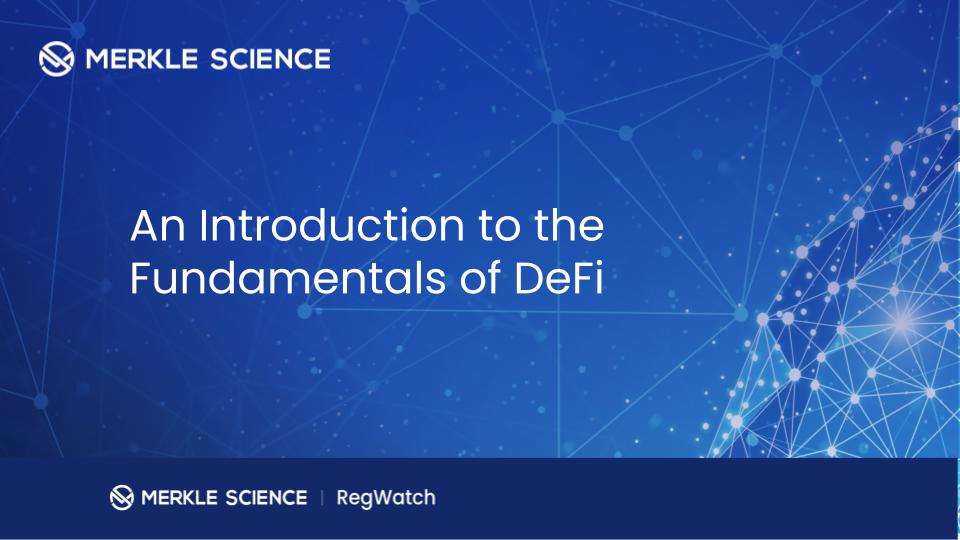DeFi 101: Understanding DeFi and Its Functions

Merkle Science

Decentralized finance (DeFi) is the confluence of blockchain technology and financial applications. It enables the execution of financial transactions through decentralized applications (dApps) that are essentially, services built upon public blockchains. Through smart contracts, DeFi looks to increase efficiency and accuracy by replacing intermediaries with products such as Automated Market Makers (AMMs).
For the cryptocurrency industry, 2021 is pegged to be the year of decentralized finance. As per industry reports, the total volume locked (TVL) — which measures the amount locked into DeFi platforms for liquidity purposes — in the DeFi sector crossed $1 billion in February 2021. Even though the TVL locked in DeFi platforms has gone down since its peak in May 2021, the amount of investment in DeFi platforms remains significantly higher than the year before. In fact, some platforms have been doing exceptionally well. The TVL on platforms such as MakerDAO, Compound, Uniswap, and Aave have grown from $1 billion USD in May 2020 to $88 billion USD at its peak. With all the buzz surrounding DeFi, we must begin understanding the fundamentals of this innovative technology and how we may leverage this developing financial frontier.
DeFi Building Blocks
DeFi finds its roots in the immutable blockchain network with built-in smart contracts. To begin understanding the ecosystem, it’s important to understand some concepts that are essential to the DeFi landscape.
- The FATF defines smart contracts as “a computer program or a protocol that is designed to automatically execute specific actions such as Virtual Assets (VA) transfer between participants without the direct involvement of a third party when certain conditions are met.” Smart contracts such as Ethereum allow its users to encode rules for executing and enforcing DeFi transactions.
- Automated Market Makers (AMMs) were created to solve the liquidity problem of DeFi. Liquidity refers to how easily one asset may be converted into another without having much price impact. While not all decentralized exchanges are AMM platforms, some of the most popular DEX’s are. AMM platforms allow cryptocurrencies to be traded automatically using a programmed liquidity pool rather than a traditional order book, which brings together buyers and sellers. AMM platforms collect funds into a liquidity pool via a smart contract in order to facilitate decentralized trading, lending, and other financial functions. Liquidity providers add tokens in a pool and are incentivized to provide liquidity to a market so that the tokens are traded easily on the platform. They earn a trading fee proportional to their share of total liquidity for the trades that take place within their pool.
- Governance in a lot of DeFi platforms is driven by the token system. Governance tokens can be utilized to facilitate decision-making functions on the blockchain such as the right to vote for a change on the protocol, defining parameters on the interest rate, or collateralization ratios.
What Are Some Popular DeFi Functions?
The DeFi ecosystem has evolved beyond simple peer-to-peer transactions into a myriad of financial functions, all validated and secured on the blockchain without intermediaries. DeFi users are able to leverage lending and borrowing platforms to facilitate peer-to-peer (P2P) lending, allowing crypto holders to make a return on their assets. Decentralized exchanges (DEXs) act as P2P markets that directly connect buyers with sellers without involving any verifiable operator. Yield aggregators allow users and depositors to maximize profits through lending, providing liquidity, or staking funds across multiple platforms. Further, oracles act as third-party data sources that provide blockchains with real-world, off-chain information so platforms may execute transactions more effectively. Last but not least, insurance protocols provide protection against trading risks on DeFi platforms in return for a guaranteed premium fee.
How Merkle Science Can Help
Merkle Science believes in smart regulation around DeFi. In order to do so, industry players — from crypto businesses and financial institutions to regulators and law enforcement agencies — must understand the lay of the land and how the DeFi ecosystem operates. Merkle Science published a primer, especially well-suited for those who have started navigating DeFi, that gives an overview of the types of DeFi platforms, emerging trends, regulatory concerns, as well as risks individuals should be aware of when engaging with the ecosystem, download the guide here.



